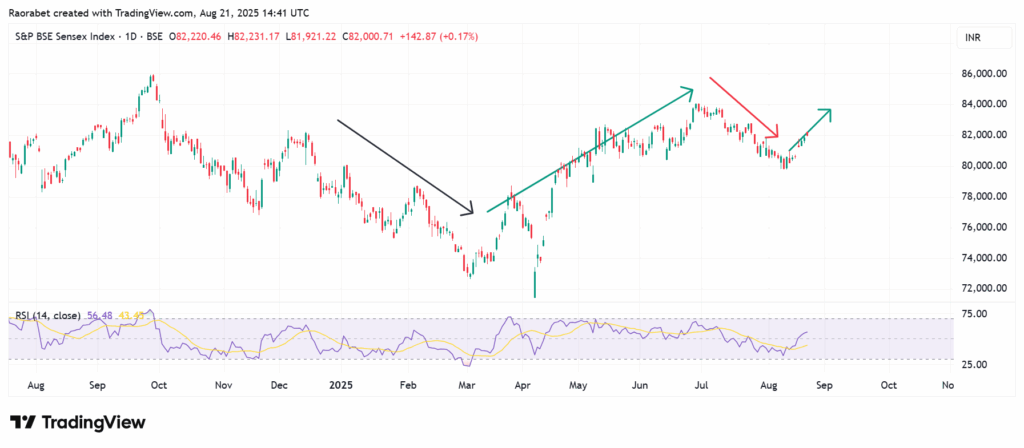- The BSE Sensex, India's benchmark index, has had a lot of ups and downs in Q3 2025 due to strong domestic conditions and global headwinds.
The Bombay Stock Exchange (BSE) had a very different path in the third quarter of 2025 than it had in the first half of the year. The BSE Sensex, India’s benchmark stock market index, has had a lot of ups and downs in Q3 2025 because of strong domestic conditions and tough global conditions.
The index is at 82,000 as of this writing, which means that it has gained 4.77% year-to-date and 1.65% over the past year, amidst recent rising volatility. H1 2025 was marked by volatility and a significant drop in the middle of the period. However, Q3 saw a strong rebound thanks to a combination of favorable local fundamentals and improving global sentiment. This change shows that India is becoming more resilient to shocks from outside the country and is becoming a more stable place to invest.
The BSE’s Adrenaline-Filled H1 2025
The BSE Q1 2025 performance was quite an adrenaline rush, with periods of notable growth uptick and periods of prolonged decline. The benchmark Sensex started the year at almost 78,000 and fell to a 52-week low of 71,400 in April.
Global challenges, such as ongoing trade tensions and foreign institutional investor (FII) withdrawals, were mostly responsible for this decline. For the period to March, Indian equities saw five months in a row of FPI outflows, which put a lot of pressure on the market. The market, however, began a robust recovery in March, going on to post four straight months of gains before finally peaking at 84,000 at the end of June, its highest point in nine months.
Key Fundamentals & Technicals In Play In H1
- Fundamentals: In the first half of the year 2025, the economic environment was characterized by a combination of opportunities and problems. The most important basic factor was the strong domestic demand and the considerable participation of domestic institutional investors (DIIs). The first half saw FIIs sell more than they bought (with $8.2 billion leaving the country). However, DIIs brought in an incredible $41.5 billion, which helped protect against the foreign outflow.
Meanwhile, inflation fell below 5%, which allowed the Reserve Bank of India (RBI) keep the repo rate steady at 6.5%, which boosted market confidence. Global factors, like the US Federal Reserve’s relaxing of its policies, also made it easier for foreign money to flow in, but geopolitical tensions made it less so.
• Technical Metrics: It was important from a technical point of view that the market bounced back from its April lows. The Sensex’s rise broke through important barrier levels. The 20-day exponential moving average (EMA) became an important support level, showing that the market was going up for a long time. By the end of June, the market capitalization of companies listed on the BSE had risen by more than 18.6% in rupee terms, hitting ₹462 lakh crore.
Q3 2025: The Rebound and Momentum
The BSE has been going up in the third quarter of 2025, building on the momentum it had gained in the second half of the year. The surge has continued this quarter, thanks to good conditions at home and an improved sentiment around the world.
The earnings season for the Q3 will be quite important. Strong corporate results will support the current high valuations and keep the surge going.
Q3 Fundamentals & Technicals
- Fundamentals: The main reasons for Q3 performance were a decrease in global trade uncertainty, a steady drop in inflation, and strong domestic demand in India. Falling inflation gave the RBI the opportunity to make monetary policy more flexible, which led to rate decreases of 100 basis points between February and June. Also, the Indian economy showed signs of getting stronger, with strong private consumption spending.
- Technical Performance Metrics: From a technical point of view, the Q3 performance was marked by a continuation of the uptrend. Additionally, the market capitalization of the BSE maintained its rising trend. The strong Sensex Price-to-Earnings (P/E) ratio showed that investors were more confident and that stocks were worth more.
Average daily turnover stayed high, and that meant there was strong liquidity and steady trading volumes. Meanwhile FII inflows, which went from being net sellers to moderate inflows, was an important sign of restored foreign interest. This, along with the steady support from DII, made for a strong bullish momentum.

BSE Sensex Index Performance on a daily chart to Q3 2025. Source: TradingView
BSE Outlook for Q4 2025
The last three months of 2025 look good, and analysts anticipate the Sensex will go up a little bit. Forecasts range from 82,000 (Morgan Stanley’s amended forecast) to 85,100 (the median of a Reuters survey). Also, a forecast 7% increase in GDP in the second half of FY25, thanks to holiday spending and capital spending, will likely improve performance.
Also, foreign capital flows are likely to increase as global geopolitical tensions ease and interest rates become more stable around the world. The robust investment and spending cycles are expected to persist domestically. If the index stays above 81,000, the outlook is technically positive. The 200-day SMA at about 80,500 is a good support level, while the RSI over 60 favors buyers.
In Summary
In conclusion, H1’s 7% growth showed strength, while Q3’s 1.9% drop showed weaknesses, which has created a cautious tone for Q4. In a market that has shown both strength and underlying weakness, investors should keep an eye on trade policy and earnings and look for selective opportunities.
This article was originally published on InvestingCube.com. Republishing without permission is prohibited.


